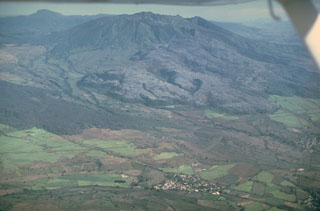Global Volcanism Program | Image GVP-03659

Volcán Ceboruco is a small, but complex stratovolcano with two concentric summit calderas. The thick lava flow (center) on the western flank was emplaced during an eruption in 1870-75. Eruption of the rhyodacite Jala Pumice formed the initial 4-km-wide caldera about 1,000 years ago. The second caldera was associated with partial collapse of the large Dos Equis dacite lava dome, which partly filled the earlier caldera. About 15 scoria cones and lava flows are across the flanks.
Photo by Jim Luhr, 1980 (Smithsonian Institution).
![]() This image is made available under the Public Domain Dedication CC0 license, but proper attribution is appreciated.
This image is made available under the Public Domain Dedication CC0 license, but proper attribution is appreciated.
Keywords: stratovolcano | lava flow | caldera

Ceboruco
